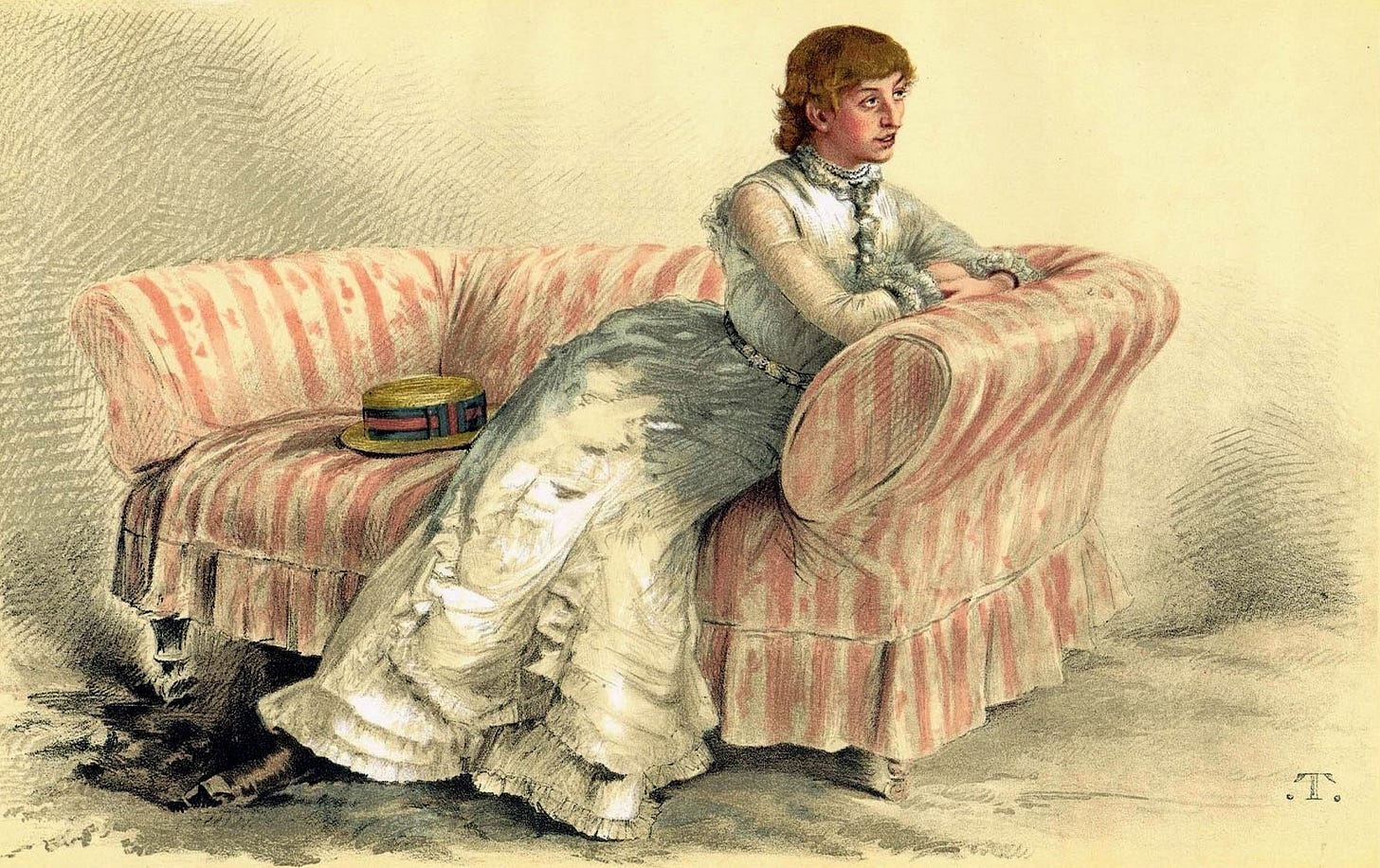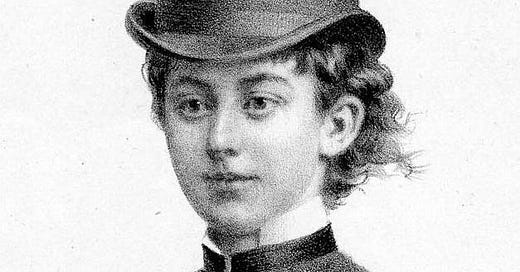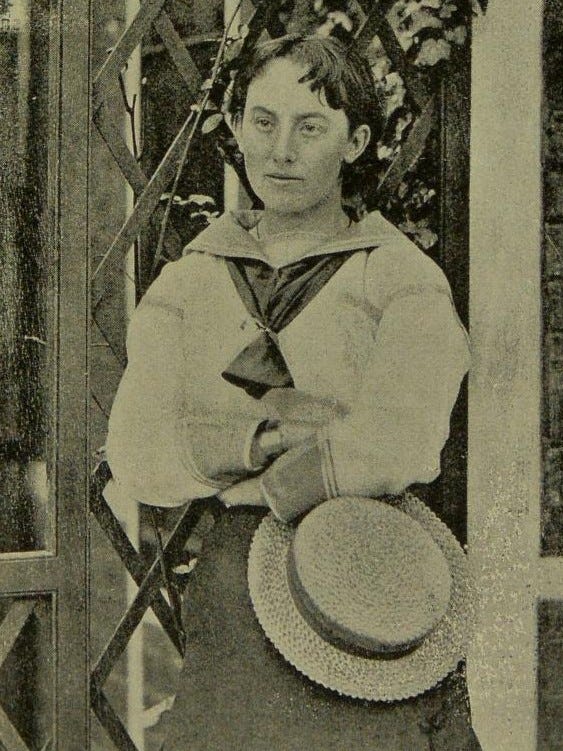Lady Florence Dixie: A Victorian Adventurer in Patagonia
How an aristocratic woman went against tradition to become the first female tourist in Patagonia and wrote a book about it
On Dec. 11, 1878, Lady Florence Dixie set off from England for a six-month horse-riding expedition through Patagonia.1 Based on her adventures, she wrote Across Patagonia, one of the first English travel narratives from the perspective of a woman.
In Across Patagonia, Florence Dixie describes the reason for the expedition as a desire to get away. As she says, “Palled for the moment with civilization and its surroundings, I wanted to escape somewhere, where I might be as far removed from them as possible.”
She chose Patagonia,
precisely because it was an outlandish place and so far away. […] Nowhere else are you so completely alone. Nowhere else is there an area of 100,000 square miles which you may gallop over, and where, whilst enjoying a healthy, bracing climate, you are safe from the persecutions of fevers, friends, […] telegrams, letters, and every other nuisance you are elsewhere liable to be exposed to. To these attractions was added the thought, always alluring to an active mind, that there too I should be able to penetrate into vast wilds, virgin as yet to the foot of man. Scenes of infinite beauty and grandeur might be lying hidden in the silent solitude of the mountains which bound the barren plains of the Pampas, into whose mysterious recesses no one as yet had ever ventured. And I was to be the first to behold them? —an egotistical pleasure, it is true; but the idea had a great charm for me, as it has had for many others.
Twenty-three-year-old Florence Dixie was accompanied on the trip by her husband, Sir Alexander Beaumont Churchill Dixie; her oldest brother, Lord Queensberry (the 9th Marquess of Queensberry, who was later responsible for Oscar Wilde’s imprisonment and demise due to Wilde’s relationship with Lord Queensberry’s son Afred “Bosie” Douglas); a family friend, Mr. J. Beerbohm (who had recently published Wanderings in Patagonia); one British servant, Storer; and four local guides. She left behind her two sons, the younger of whom was only two and a half months old.2
Following in the tradition of travel writers at the time, Dixie’s narrative is heavily influenced by Romanticism, which emphasizes the sublime with descriptions of “virgin nature,”3 and colonial stereotypes of indigenous people. And yet, Dixie also allows room for a mutual gaze, acknowledging how the group of foreigners must have appeared to the native Tehuelche they encountered.
I was also struck by how much of an adventure story it is, with danger at every turn—a carriage overturns three times in one day, wildfire across the plains surround them before they can escape, pumas appear suddenly in their midst, they’re on the brink of losing all their horses twice—and descriptions of hunting full of adrenaline.
Dixie was the sole woman of the expedition, but she casts herself as the driving force of the trip and as a full participant—if not a leader—in the traditionally masculine occupation of hunting. Hers is often the horse at the front of the pack.
While she acknowledges her femininity briefly at the beginning of the narrative, she quickly dismisses any associations with “female fickleness” or “weakness” of emotion. She later tells the reader she is no good at sewing (a traditionally female occupation), and when she describes how the dreariness of the treeless plains affected her emotions, she makes a point of saying everyone in the group felt the same way.
Really, the only hints in the book that Dixie has more stereotypically feminine emotions come from her concern over a mare who loses a foal, her affection for a baby guanaco that she wants to adopt (before she realizes it’s been mortally injured by the hunting dogs), and her deep remorse over killing a deer.4 Otherwise, Dixie casts herself as simply one of the group of hardy adventurers.
This wasn’t the first time Florence Dixie bucked tradition to take on a more masculine role. When she was presented before Queen Victoria for her coming-of-age as a noblewoman (think Bridgerton, even though that’s a different time period), Lady Florence had short hair and didn’t wear the expected finery. She was publicly censured for this, but the fact that she was riding buddies with the Prince of Wales probably saved her from being more ostracized. (He later became her younger son’s godfather, and Across Patagonia is dedicated to him.)
Even from a young age, she was no stranger to social scandal. Her father died when she was three, and he was widely believed to have killed himself. Her mother was part of a protracted legal battle over the custody of her three youngest children (including Florence) after she converted to Catholicism.
Florence grew up in a physically active family, and she participated in all of the activities her twin brother did, like riding and hunting. She always rode astride (scandalous for a woman at the time). She later became the founding president of the British Ladies’ Football Club. As she said, “There is no reason why football should not be played by women, and played well too, provided they dress rationally and relegate to limbo the straitjacket attire in which fashion delights to attire them.”

Florence Dixie didn’t shy away from expressing her strong opinions, even political ones, like her support for Irish home rule.5 When she disagreed with Charles Darwin’s description of a Patagonian mammal, she sent him a letter to correct his misunderstanding, along with a copy of her travel narrative. Darwin’s copy of Across Patagonia is now in the rare book collection of the Cambridge University Library.
After her adventures in Patagonia, she became field correspondent for the Morning Post of London and traveled to South Africa with her husband to cover the First Boer War. Her two books on that subject show sympathy for the Zulu cause, and her writing was influential in restoring to the throne the Zulu king Cetshwayo, who had been imprisoned by the British.
She eventually became an outspoken suffragette, and her later books, including two children’s books set in Patagonia, advocate forthrightly for equality between the sexes. As Fiona Mackintosh says, “Right from the author’s preface to The Young Castaways, it is clear that equality for women is on the authorial agenda: ‘The book is one written alike for girls as well as boys, and the Author hopes that there are many boys and girls into whose hands it may fall who are made of the same right stuff as Harry and Topsie [Dixie’s male and female child protagonists].”
In those books, girls and women explicitly do all the things that boys and men do, like ride horses, hunt, shoot, and become chieftains—without losing their femininity.
Florence Dixie’s support for the Women’s Movement was what she was mostly known for by the time she died, in 1905, at the age of 50. Her books are now mostly out of print, though they are accessible through public domain.
Sources:
Lady Florence Dixie, Across Patagonia (New York: Worthington, 1881)
Fiona J. Mackintosh, “Travellers’ Tropes: Lady Florence Dixie and the Penetration of Patagonia,” in Patagonia: Myths and Realities, ed. Fernanda Peñaloza, Jason Wilson, and Claudio Canaparo (Bern, Switzerland: Peter Lang, 2010)
Precious McKenzie, “Lady Florence Douglas Dixie: Hale and Hearty” in The Right Sort of Woman: Victorian Travel Writers and the Fitness of an Empire (Newcastle upon Tyne: Cambridge Scholars Publishing, 2012).
Wikipedia authors, “Lady Florence Dixie,” accessed 8 July 2024, https://en.wikipedia.org/wiki/Lady_Florence_Dixie
Though this Substack is mostly focused on Tierra del Fuego, and Dixie’s party only glimpsed the archipelago from across the Magellan Strait, I found the story of the first female tourist of Patagonia so fascinating, I couldn’t help but share here what I’ve learned about her.
Although it wasn’t uncommon at the time for women to leave the entire care of their infants to a nursemaid, I can’t help but wonder if postpartum depression contributed to Dixie’s motivation to get away.
As Fiona Mackintosh points out, Across Patagonia doesn’t question this gendered language of nature as female and the explorer as the male penetrator. As she says, “Dixie […] adopts a ventriloquised male voice, hence the observable similarity to such models as Beerbohm [author of Wanderings in Patagonia] or Musters [author of At Home with the Patagonians].” Dixie’s later writing, including two books for children set in Patagonia, “unlike the travel narrative, champion all those people and objects deemed ‘other’ by imperial or colonial masculine rhetoric (women, children, natives, and nature).”
She later spoke out strongly against blood sports, and I wonder if this experience was a turning point for her.
She may or may not have been the subject of an assassination attempt due to the support she expressed. She reported an attack to the police and the newspapers, but there weren’t any witnesses who agreed with her account. The alleged attack came up in discussion in the House of Commons on at least three separate occasions, but the police investigation was dismissed because of a lack of corroborating evidence.







Wow, love that spunk of hers! It would cool to read that letter to Darwin!